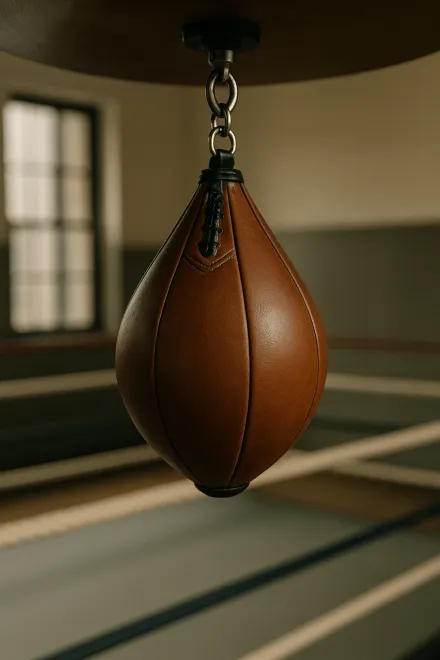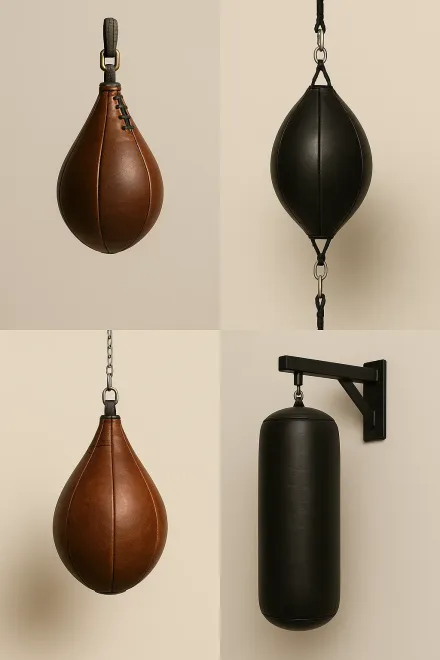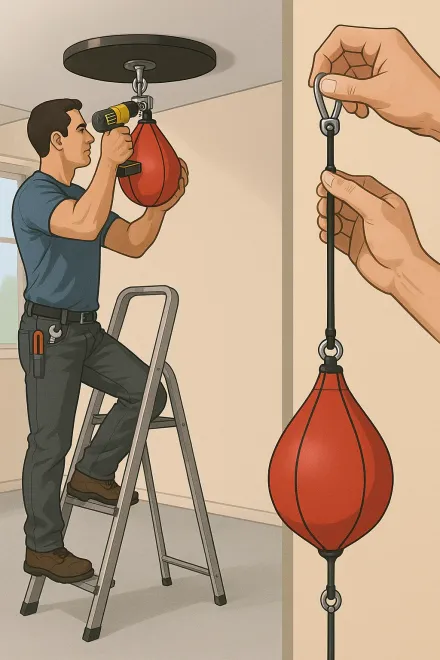Boxing speed bags
Boxing speed bags are among the most used accessories in boxing and combat sports. Their main role is to improve coordination, reflexes, speed, and strike accuracy. Unlike a heavy bag, the speed bag focuses on training agility and technique, making it essential for both beginners and pros. In this guide you'll learn everything you need about this accessory: from the different types available to how to set it up and get the most from your training.
See the best boxing speed bags on Amazon
What is a speed bag and what is it for?
The speed bag is a small air-filled bag, usually leather or synthetic, used to train hand speed, coordination, and striking accuracy. Unlike a traditional boxing bag, it's not designed to build power but agility and technique. Its key feature is a constant rebound that forces the boxer to keep proper rhythm and timing.
Among its main benefits are:
- Reflex improvement: its quick rebound forces fast reactions.
- Hand-eye coordination: ideal for syncing your eyes and fists.
- Endurance: working the bag for several minutes increases aerobic capacity.
- Precision: promotes cleaner, more controlled punches.
For these reasons, it's a common accessory in boxing and martial arts gyms, but it can also be installed at home with ease.
Types of boxing speed bags
There are different types of boxing speed bags, each with specific features suited to distinct training styles. Knowing the differences is key to choosing the right one:
- Speed bag: small and light, designed to improve rhythm, reflexes, and coordination. It's the most common in boxing gyms.
- Double-end bag: anchored to floor and ceiling with elastic cords. It rebounds in multiple directions, simulating realistic movement and demanding greater punch control.
- Tear-drop bag: larger and heavier, lets you work not only speed but also accuracy and some power.
- Wall-mount speed bag: ideal for home training when a ceiling mount isn't possible.
Your choice depends on your goals: for speed and coordination, pick a classic speed bag; for a more complete workout, a double-end or tear-drop bag are excellent options.


How to install a speed bag correctly
Installing a speed bag at home isn't complicated, but it must be done right to ensure safe, effective training. Here are some steps and tips:
- Location: choose a spacious, obstacle-free area. The bag needs room to move.
- Proper height: set it at chin height to simulate an opponent's position.
- Solid mount: for a speed bag, use a rigid platform fixed to the ceiling or wall. For a double-end bag, make sure anchor points are secure.
- Elastic cords: check cords or bands regularly, as they ensure the bag's correct rebound.
- Maintenance: add air when it softens and clean the surface to prevent wear.
With proper installation, your training will flow better and you'll extend the accessory's lifespan.
Tips for training with a speed bag
Training with the speed bag isn't just about hitting nonstop, but about applying technique and rhythm. Here are some practical tips:
- Start slow: if you're a beginner, focus on accurate strikes first, not speed.
- Keep a steady rhythm: the goal isn't hard shots but a rhythmic flow that builds endurance.
- Sync breathing and punches: breathe in a controlled way while punching to avoid quick fatigue.
- Short, sharp punches: the bag responds better to quick taps than long, powerful blows.
- Add variations: mix jabs, hooks, and small footwork to simulate real fight situations.
- Training time: start with 1–2 minutes per round and increase progressively.
With practice, you'll notice significant gains in reflexes, coordination, and ring confidence. The bag trains not only your body but also your mind, since it demands total focus.
Common mistakes when using a speed bag
Many beginners make mistakes when working the speed bag, which reduces training effectiveness and can even cause frustration. These are the most frequent:
- Hitting too hard: the bag isn't meant for power but speed and precision. Punches should be light and quick.
- Not keeping rhythm: trying to chase the rebound without technique causes discoordination. Set a rhythm and hold it.
- Poor stance: neglecting your guard or foot position can hurt your overall boxing technique.
- Lack of consistency: using the bag only occasionally yields little progress. Include it at least 3 times per week.
- Ignoring breathing: many forget to coordinate it, leading to early fatigue.
- Improper equipment use: not checking cords, air pressure, or mounts can lead to poor performance.
Avoiding these mistakes will help you get the most from your sessions, turning the speed bag into a key tool for your progress.
Frequently asked questions about speed bags
What are the benefits of training with a speed bag?
A speed bag helps improve coordination, reaction speed, punching accuracy, and cardiovascular endurance. Unlike a heavy bag, it's not focused on power but agility and reflexes. It's also a great aerobic exercise that helps burn calories and maintain solid overall fitness.
Which type of speed bag is best for beginners?
For newcomers to boxing, the classic speed bag is the top choice. It's small, light, and makes hand-eye coordination work simple. Once the boxer gains confidence, they can move to a double-end bag or a tear-drop bag for more complete training.
Can a speed bag be installed at home?
Yes, you can install one at home without issue. There are wall mounts and dedicated platforms to secure them safely. You only need clear space around it to avoid accidental hits. It's also important to ensure the ceiling or wall can handle the accessory's weight and tension.
How long should I train with the speed bag?
Ideally, start with 1 to 2-minute rounds, doing 3 to 5 rounds with short rests. Over time, you can increase both duration and intensity. The key is consistency: training at least 3 times per week delivers better results.
What's the difference between a speed bag and a heavy bag?
A heavy bag is mainly used to develop power, endurance, and strong-strike technique. In contrast, the speed bag focuses on speed, reflexes, and coordination. Both complement each other and are essential parts of any boxer's routine.
Is the speed bag useful for other combat sports?
Yes, it's useful not only for boxing but also for kickboxing, muay thai, MMA, and other combat sports. In all of them, coordination, precision, and reflexes are crucial, and the speed bag helps improve those skills.
How often should a speed bag be replaced?
A bag's lifespan depends on usage and material. A quality one can last several years with proper care, keeping elastic cords in good shape and checking air pressure. If you notice poor rebound or excessive wear, it's time to replace it.
